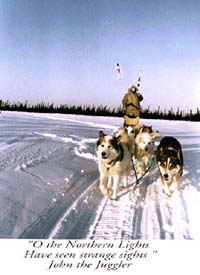Table of Contents
The Bigger Picture
*
Featured Inuit Dog Owner:
Paul Landry
*
Book Reviews:
On Thin Ice
Of Dogs and Men
*
Poem: Brave Little Heart
*
Janice Howls:
Hypothyroid Disease
*
Fan Hitch Contributor Receives Writing Award
*
Expedition News:
The Thule 2000
*
In My Humble Opinion:
Traditional Advice
*
Updates:
The Nunavut Quest 2000
Ihe ISDVMA Meeting
Navigating This
Site
Index of articles by subject
Index
of back issues by volume number
Search The
Fan Hitch
Articles
to download and print
Ordering
Ken MacRury's Thesis
Our
comprehensive list of resources
Talk
to The Fan
Hitch
The Fan
Hitch home page
ISDI
home page
Editor: Sue Hamilton
Webmaster: Mark Hamilton
Contents of The Fan Hitch Website and its publications are protected by international copyright laws. No photo, drawing or text may be reproduced in any form without written consent. Webmasters please note: written consent is necessary before linking this site to yours! Please forward requests to Sue Hamilton, 55 Town Line Rd., Harwinton, Connecticut 06791, USA or mail@thefanhitch.org

In My Humble Opinion: Traditional Advice
by Mark Hamilton
"Jayko, the puppies are fighting. I mean, this is serious stuff, not play. Tiri's pups aren't even four weeks old and they're grabbing each other by the scruff of the neck and growling and shaking their head's violently. They don't stop until the other one is shrieking. Amaruq's pups are two weeks older and quite a bit larger, now they're bullying Tiri's pups. What do we do?"
With a chuckle Jayko responded, “Let them fight. They can't kill each other at this age." At the time we took his admonition to mean, "Oh, it's nothing to worry about, they won't do any permanent damage to each other." Now, we realize he was saying so much more.
That is often the case with "traditional wisdom". Simple sounding statements hold a depth and breadth of information that is easily overlooked at the time. Another of Jayko's pieces of advice will help illustrate this point, "Don't feed them too much meat, their legs will be too short."
Well, we accepted that one at face value, and since the pups' primary food source was EAGLE POWER PACK we didn't worry over the point. Later we mentioned Jayko's advice to the chief veterinarian at EAGLE, Dr. Al Townsend. His immediate response was that it was very sound guidance as too much meat could throw off the calcium/phosphorous ratio which would result in short legs. The thing is, at the time we didn't realize Jayko was warning us to be sure to feed a balanced diet.
Similarly, an ISD in the north learns from the start that
its job in the contract between human and dog is to supply
the
means of locomotion. Their natural instinct to pull
is reinforced as appropriate behavior. Arctic
mushers don't encourage bad pulling habits by “pedaling”
or running along side their komotik. I well remember
several times in Greenland when, faced with a long and
steep uphill climb, we offered to get off the komotik to
lighten the load for the dogs. Always the answer was quite
emphatic that the dogs would pull us up, and of course
they did. Now on reflection it sounds a lot to me like
Jamie Nelson's advice that you need to teach your dogs to
pull. These days we realize how much more Jayko was saying
when he advised us to "let them fight". He was telling us
this is a breed driven to established itself within the
hierarchy of dominance within their pack. They must find
their place and defend that position. Let them establish
the ground rules while they are incapable of doing extreme
damage to each other, because if you don't let them do it
when they’re little, you won't like the consequences when
they do it later.